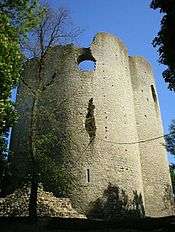Étampes
| Étampes | ||
|---|---|---|
|
Saint Martin | ||
| ||
 Étampes | ||
|
Location within Île-de-France region  Étampes | ||
| Coordinates: 48°26′03″N 2°09′41″E / 48.4343°N 2.1615°ECoordinates: 48°26′03″N 2°09′41″E / 48.4343°N 2.1615°E | ||
| Country | France | |
| Region | Île-de-France | |
| Department | Essonne | |
| Arrondissement | Étampes | |
| Intercommunality | Étampois | |
| Government | ||
| • Mayor (2008–2014) | Franck Marlin | |
| Area1 | 40.92 km2 (15.80 sq mi) | |
| Population (2006)2 | 22,679 | |
| • Density | 550/km2 (1,400/sq mi) | |
| Time zone | CET (UTC+1) | |
| • Summer (DST) | CEST (UTC+2) | |
| INSEE/Postal code | 91223 / 91150 | |
| Elevation | 66–156 m (217–512 ft) | |
|
1 French Land Register data, which excludes lakes, ponds, glaciers > 1 km² (0.386 sq mi or 247 acres) and river estuaries. 2 Population without double counting: residents of multiple communes (e.g., students and military personnel) only counted once. | ||
Étampes (French pronunciation: [etɑ̃p]) is a commune in the metropolitan area of Paris, France. It is located 48.1 km (29.9 mi) south-southwest from the center of Paris (as the crow flies). Étampes is a sub-prefecture of the Essonne department.
Étampes, together with the neighboring communes of Morigny-Champigny and Brières-les-Scellés, form an urban area of 26,604 inhabitants (1999 census). This urban area is a "satellite city" of Paris.
History
Étampes (Latin: Stampae) existed at the beginning of the 7th century and in the early Middle Ages belonged to the crown domain. During the Middle Ages it was the scene of several councils, the most notable of which took place in 1130 and resulted in the recognition of Innocent II as the legitimate pope. In 1652, during the war of the Fronde it suffered severely at the hands of the royal troops under Turenne.
Geography
Étampes lies on the beautiful river Chalouette, a tributary of the Juine, which borders the eastern outskirts of the serene town.
Inhabitants of Étampes are known as Étampois.
Transport
Étampes is served by two stations on Paris RER line C: Étampes and Saint-Martin d'Étampes.
Sights
A fine view of Étampes is obtained from the Tour Guinette, a keep (now ruined) built by Louis VI in the 12th century on an eminence on the other side of the railway. Notre-Dame du Fort, the chief church, dates from the 11th and 12th centuries; irregular in plan, it is remarkable for a fine Romanesque tower and spire, and for the crenellated wall which partly surrounds it. The interior contains ancient paintings and other artistic works. St Basile (12th and 16th centuries), which preserves a Romanesque doorway, and St Martin (12th and 13th centuries), with a leaning tower of the 16th century, are of less importance.
The civil buildings offer little interest, but two houses named after Anne de Pisseleu, mistress of Francis I, and Diane de Poitiers, mistress of Henry II, are graceful examples of Renaissance architecture. In the square there is a statue of the naturalist, Étienne Geoffroy Saint-Hilaire, who was born in Étampes.
Monuments and tourist attractions
 La Tour Guinette-the remains of Château d'Étampes
La Tour Guinette-the remains of Château d'Étampes L'Hôtel de Ville
L'Hôtel de Ville L'Hôtel de Ville
L'Hôtel de Ville
- Hôtel Anne-de-Pisseleu
- Théâtre buily by the architect Gabriel Davioud in 1851-1852, paid for by a public subscription
- Regional leisure park (wave pool)
- Sculptures created by André Deluol : Vénus anadyomène, La Terre, Le Corbeau et le Renard, Jeune fille et oiseau, Un Ange, Deux danseuses nues
Religious edifices
- Église Notre Dame du Fort
 Église Notre-Dame-du-Fort
Église Notre-Dame-du-Fort Église Notre-Dame-du-Fort
Église Notre-Dame-du-Fort Église Notre-Dame-du-Fort
Église Notre-Dame-du-Fort Église Notre-Dame-du-Fort
Église Notre-Dame-du-Fort
- Église Saint-Basile
 Église Saint-Basile
Église Saint-Basile Église Saint-Basile
Église Saint-Basile Église Saint-Basile
Église Saint-Basile
- Église Saint-Martin, famous for its leaning tour
 Église Saint-Martin
Église Saint-Martin Église Saint-Martin
Église Saint-Martin Église Saint-Martin
Église Saint-Martin Église Saint-Martin
Église Saint-Martin
- Église Saint-Gilles
 Église Saint-Gilles
Église Saint-Gilles Église Saint-Gilles
Église Saint-Gilles Église Saint-Gilles
Église Saint-Gilles Église Saint-Gilles
Église Saint-Gilles Église Saint-Gilles
Église Saint-Gilles Église Saint-Gilles
Église Saint-Gilles Église Saint-Gilles
Église Saint-Gilles
- Chapelle de Gérofosse
- Chapelle de Guinette
Notable Persons
- Louise Abbéma painter, sculptor, and designer
- Theobald of Étampes
- Yacouba Sylla footballer
- Bilal Ouali footballer
Miscellaneous
The subprefecture, a tribunal of first instance, and a communal college are among the public institutions of Étampes.
See also
References
- INSEE
- Mayors of Essonne Association (French)
- The "Pergola de la Douce France" is located in the gardens of the Tour Guinette in Étampes and was part of a larger composition created in 1925 for the Exposition des Arts décoratifs et industriels. It was acquired by Étampes in 1934. The work comprises four large stone blocks on which sixteen bas-reliefs have been created by various sculptors.Georges Saupique executed the reliefs "Le Saint Graal" and "L’Aurochs".
 This article incorporates text from a publication now in the public domain: Chisholm, Hugh, ed. (1911). "article name needed". Encyclopædia Britannica (11th ed.). Cambridge University Press.
This article incorporates text from a publication now in the public domain: Chisholm, Hugh, ed. (1911). "article name needed". Encyclopædia Britannica (11th ed.). Cambridge University Press.
External links
| Wikimedia Commons has media related to Étampes. |
- Étampes city council website
- Mérimée database - Cultural heritage (French)
- Land use (IAURIF) (English)
- La Base des Loisirs, The city's park's website
.svg.png)